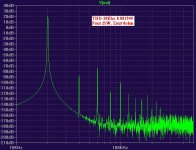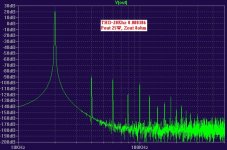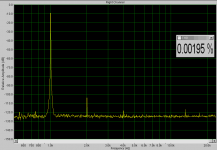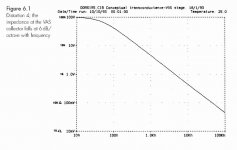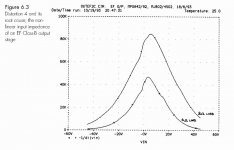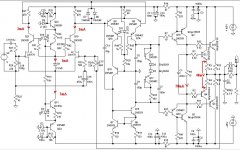lumanauw said:Hi, Roender,
What is the effect if you split R18(68ohm) into 2 resistors, each 136ohm, one for emitor of Q8 and one for emitor of Q9 (splitting the differential VAS)?
I see this change in one amp, the earlier model uses differential VAS, but in the later model, they split the VAS (not forming differential VAS anymore). What is the effect?
With this change you heavily drop open loop gain. An early prototype of symasym was using this scheme. Changing to differential VAS gave a stunning impovement in sonics here.
AAK said:Hi roender,
I cut both 47k on my symasym and alls well. I haven't put and ear to it, but everything including THD measures the same. Simulations don't show any difference either.
Al
I get slightly better measurings with the rloads, and in early prototype the sound was far more relaxed with the rloads.
Possible that i compensated something else...
Roender, can you do real world measurings?
Mike
MikeB said:
Roender, can you do real world measurings?
Mike
Hi Mike
Right now, I can not do more than scope stability tests.
I will try to transform my pc in a FFTmeter but I don't know if it is possible with SB Audigy 1 card.
As I promise, I will send you all my work to construct your version an measure it
"... the compensation capacitor reduces the second stage output impedance, so that the non-linear loading on it due to the input impedance of the third stage generates less distortion than might be expected" (Audio Power Amplifier Design Handbook)
Maybe that's why the effect of output VAS Rlodas is not visible in original symasym, because original amp version has a low output stage input impedance and is more prone to backinject crossover (and not only) signals in VAS
Mike, what do you think about?
Best regards,
Mihai
Maybe that's why the effect of output VAS Rlodas is not visible in original symasym, because original amp version has a low output stage input impedance and is more prone to backinject crossover (and not only) signals in VAS
Mike, what do you think about?
Best regards,
Mihai
Connection between VAS output (collector) with predriver or driver (base) is really a problem. Nature wants the signal flows from low impedance, and the receiving point is higher impedance, about 10-20X of the transmitting impedance. (unless you want max power transfer, then the output impedance=receiving input impedance)
VAS collector has higher impedance than predriver's base impedance.
Putting miller cap lowers the output impedance of VAS, but not linear (towards frequency). The input impedance of predriver's base also non linear.
Putting R at collector of VAS helps to lower impedance that is not dependant on frequency.
VAS output impedance is decending like a hill. At 3khz about 1kohm
VAS collector has higher impedance than predriver's base impedance.
Putting miller cap lowers the output impedance of VAS, but not linear (towards frequency). The input impedance of predriver's base also non linear.
Putting R at collector of VAS helps to lower impedance that is not dependant on frequency.
VAS output impedance is decending like a hill. At 3khz about 1kohm
Attachments
Correction: "DRIVER" input impedance !lumanauw said:Predriver input impedance is like this :
In power symasym final stage, I used CFP "transistor" as a driver. The input impedance is over 1Mohm at any audio freq.
There is no need for making VAS output more impedance linear (as a fuction of freq).
Hi Mike,
The difference with or without the 47Ks is very small. A slight increase in 2HD. I thought I would never say it, but I think symasym could actually benefit from adding some low order distortion. Don't get me wrong I think symasym sounds great. But when I compare it with an amplifier with higher low order distortion, mainly 2HD, I seem to perfer that sound. Of course, It may not all be in THD, there may be some other factors like the differences in components, etc. Maybe different input capacitors. A auricap vs. wima. Could be the difference.
So, without changing symasym in any way, I started working on a tube front end to drive symasym. I figured symasym's very low THD driven by a tube may just add the write amount of THD to create a magical combination.
Any thoughts?
Al
The difference with or without the 47Ks is very small. A slight increase in 2HD. I thought I would never say it, but I think symasym could actually benefit from adding some low order distortion. Don't get me wrong I think symasym sounds great. But when I compare it with an amplifier with higher low order distortion, mainly 2HD, I seem to perfer that sound. Of course, It may not all be in THD, there may be some other factors like the differences in components, etc. Maybe different input capacitors. A auricap vs. wima. Could be the difference.
So, without changing symasym in any way, I started working on a tube front end to drive symasym. I figured symasym's very low THD driven by a tube may just add the write amount of THD to create a magical combination.
Any thoughts?
Al
On a more mundane note.
Others have built with ThermalTrak devices in the past, yet I’ve not seen any analysis of the benefits that should ensue in the way of bias stability and quiescent current control on widely varying device temp. Do they really work? Any data (other than OnSemi’s)? How would others determine their effectiveness anyway?
Brian.
Others have built with ThermalTrak devices in the past, yet I’ve not seen any analysis of the benefits that should ensue in the way of bias stability and quiescent current control on widely varying device temp. Do they really work? Any data (other than OnSemi’s)? How would others determine their effectiveness anyway?
Brian.
Hi Dado,
Q13 is bounded with Q19 and Q17 with Q20. You can see that on pictures above, in the beginning of the thread
Q13 is bounded with Q19 and Q17 with Q20. You can see that on pictures above, in the beginning of the thread
Hi Mihai, I did not notice it, sorry.
So you have two kind of the temperature follower, with transistors folowing drivers temperature and with thermal diodes following output transistors temperature? You say that bias current is quite stabile?
dado
So you have two kind of the temperature follower, with transistors folowing drivers temperature and with thermal diodes following output transistors temperature? You say that bias current is quite stabile?
dado
Roender !
Many congratulations for the Design !
I built the original Symasym 5.3, with Styroflex / Mica Capacitors, and the others are all Wima MKS2. The Output deviced are MJL1302 and 3281. I'm very amazed of how good it sounds, and I'm searching for a higher powerful version. I also found the AAK version of Symasym, and wrote a post to him too.
As I was saying, I LOVE the symasym sound (and the deep tight "jazz" bass). Despite I'm searching for a more powerful version of Symasym, I wouldn't want to leave it's sweet sound.
So, what can I expect from your amp ?
How much power @ 8Ohms load in a very SAFE operation ?
I'm searching for something about 120W @ 8 Ohms.
Thank you very much !!
Best Regards !!
edit: I'd like to keep the output devices, can I use MJL1302 / 3201 ? I can use a pair if is necessary.
Many congratulations for the Design !
I built the original Symasym 5.3, with Styroflex / Mica Capacitors, and the others are all Wima MKS2. The Output deviced are MJL1302 and 3281. I'm very amazed of how good it sounds, and I'm searching for a higher powerful version. I also found the AAK version of Symasym, and wrote a post to him too.
As I was saying, I LOVE the symasym sound (and the deep tight "jazz" bass). Despite I'm searching for a more powerful version of Symasym, I wouldn't want to leave it's sweet sound.
So, what can I expect from your amp ?
How much power @ 8Ohms load in a very SAFE operation ?
I'm searching for something about 120W @ 8 Ohms.
Thank you very much !!
Best Regards !!
edit: I'd like to keep the output devices, can I use MJL1302 / 3201 ? I can use a pair if is necessary.
One more question
Hi Mihai,
Is there a specific reason for using the 2sk170, or is that just a preferred device of you...
Anyway, think there will be no difference using ordinary bjt's there...
Regards
Hi Mihai,
Is there a specific reason for using the 2sk170, or is that just a preferred device of you...
Anyway, think there will be no difference using ordinary bjt's there...
Regards
Re: One more question
Way wrong!!!
The difference is easily audible, without the need for direct compare. The jfets sound more relaxed.
Mike
weissi said:
Anyway, think there will be no difference using ordinary bjt's there...
Regards
Way wrong!!!
The difference is easily audible, without the need for direct compare. The jfets sound more relaxed.
Mike
feeling honored that the great mastermind of symasym answers me, really and without the austrian "schmäh" !
So, what I am supposed to use instead? I don't want to put that much effort in a ordinary power amplifier to understand all those discrete devices.
Don't get me wrong, but I do not want to put that much effort into power amplifiers, my time is very, very limited.... personally I prefer doing DAC's right as I experienced more difference optimizing DAC's than amp's....
Anyway, I'm running an active system, currently speakers are driven by simple balanced gainclones. I just wanted to try out the famous symasym... with available devices that I have... these are Thermaltrak BJT's, thanks to ONSEMI 😉
2sk170 are not very commonly available here, so what can you recommend me to use in ROENDES schematics (As I think this is the most advanced amp schematic available for diy Thermaltrak use...)
Regards,
Markus
So, what I am supposed to use instead? I don't want to put that much effort in a ordinary power amplifier to understand all those discrete devices.
Don't get me wrong, but I do not want to put that much effort into power amplifiers, my time is very, very limited.... personally I prefer doing DAC's right as I experienced more difference optimizing DAC's than amp's....
Anyway, I'm running an active system, currently speakers are driven by simple balanced gainclones. I just wanted to try out the famous symasym... with available devices that I have... these are Thermaltrak BJT's, thanks to ONSEMI 😉
2sk170 are not very commonly available here, so what can you recommend me to use in ROENDES schematics (As I think this is the most advanced amp schematic available for diy Thermaltrak use...)
Regards,
Markus
- Status
- Not open for further replies.
- Home
- Amplifiers
- Solid State
- Symasym - Roender Style
